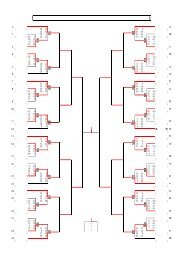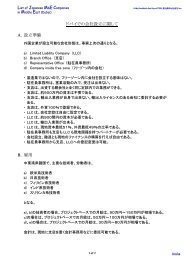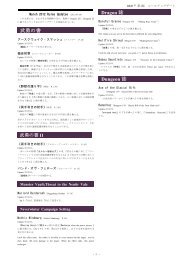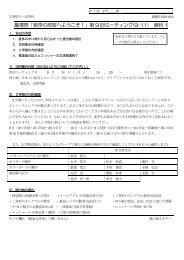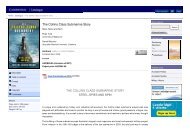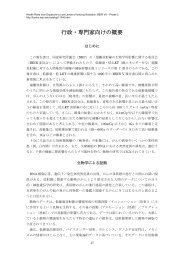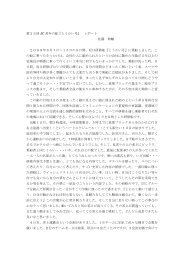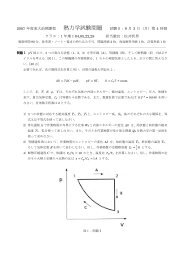cDNA Microarray Analysis of Rice Anther Genes under Chilling ...
cDNA Microarray Analysis of Rice Anther Genes under Chilling ...
cDNA Microarray Analysis of Rice Anther Genes under Chilling ...
You also want an ePaper? Increase the reach of your titles
YUMPU automatically turns print PDFs into web optimized ePapers that Google loves.
logarithmic transformation <strong>of</strong> each signal intensity.Subsequently, Z scores were calculated to normalizethe sample values to account for variations in RNAlabeling, according to the formula Z ¼ð Þ=,where and are the mean and standard deviation <strong>of</strong>about 4500 values which are spotted on half <strong>of</strong> oneslide respectively. Finally, for each EST, two Z scores <strong>of</strong>duplicate spots on a glass slide were averaged. EST wasconsidered to be chilling-inducible or chilling-repressibleif the difference <strong>of</strong> averaged Z score (unchilled Zscore chilled Z score) was below 1:0 or above 1.0respectively. Approximately, a difference <strong>of</strong> averaged Zscores <strong>of</strong> 1.0 corresponds to a two-fold difference inoriginal signal intensity. As many as 160 ESTs wereidentified as being potentially responsive to chillingstress in rice anther at the early microspore stage, as theywere found reproducibly in 2 experiments. Of thesegenes, the expression <strong>of</strong> 38 (24%) was up-regulated andthat <strong>of</strong> 122 (76%) was down-regulated. These 160 ESTswere classified according to their putative functionsbased on EST descriptions and a protein database searchby BLAST algorithm (annotations with similarity scoresgreater than 40 bits) (Table 1). About 36% <strong>of</strong> thechilling-responsive ESTs are <strong>of</strong> unknown function. Most<strong>of</strong> the chilling-responsive ESTs related to primarymetabolism, signal transduction, defense, proteolysisincluding proteases, and secondary metabolism including12-oxo-phytodienoic acid reductases (OPDARs)showed down-regulation. In contrast, genes related totranslation, such as ribosomal protein, showed upregulationin chilled anthers (Table 1).<strong>Analysis</strong> <strong>of</strong> rice OPDARs and SAMDCsAmong the 8,987 rice ESTs on the microarray, 5ESTs are annotated to encode OPDARs and 4 <strong>of</strong> themwere down-regulated by chilling stress in rice anther.There are at least 3 copies <strong>of</strong> OPDAR in the ricegenome. The sequence <strong>of</strong> the most chilling-responsiveclone (accession number C26097) was almost identicalto the nucleotide sequence <strong>of</strong> an ORF in AP003525,which is derived from chromosome 6 at 32.7 cM. Wedesignated this gene OPDAR1 (DDBJ accessionNo. AB122088). Two chilling-responsive clones (accessionnumbers C96685 and AU093231) also encodedOPDAR1. One chilling-responsive EST clone (accessionnumber AU057040) and one non chilling-responsiveEST clone (accession number D24670) encodedanother copy <strong>of</strong> OPDAR on chromosome 6. These ESTclones have up to 88% identities to OPDAR1, but thelength <strong>of</strong> the responsive one is about 0.8 kb and that <strong>of</strong>the non chilling-responsive one is about 0.5 kb. Amongthe 8,987 rice ESTs on the microarray, 5 ESTs wereannotated to encode S-adenosylmethionine decarboxylases(SAMDCs) and 3 <strong>of</strong> them were up-regulated bychilling stress in rice anther. There are at least 3 copies<strong>of</strong> SAMDC in the rice genome. The sequence <strong>of</strong> the mostchilling-responsive clone (accession number C28220)was almost identical to the nucleotide sequence <strong>of</strong> an<strong>Rice</strong> <strong>Anther</strong> <strong>Genes</strong> <strong>under</strong> <strong>Chilling</strong> Stress 1317ORF in AP005420 which is derived from chromosome9. We designated this gene SAMDC1 (DDBJ accessionNo. AB122089). One chilling-responsive clone (accessionnumber AU062686) also encoded SAMDC1. Onechilling-responsive EST clone (accession numberC26568) encoded another copy <strong>of</strong> SAMDC on chromosome4. It has up to 89% identity to SAMDC1. Two nonchilling-responsive EST clones (accession numbersAU100691 and AU056203) encoded yet another copy<strong>of</strong> SAMDC on chromosome 2, and has up to 85%identity to SAMDC1.Sequence analysis <strong>of</strong> Radc1Among the 8,987 rice ESTs on the microarray, 2ESTs (accession numbers AU172968 and AU174285)with almost identical nucleotide sequences were remarkablydown-regulated by chilling stress in riceanther. The sequences <strong>of</strong> these were almost identical tothe nucleotide sequence <strong>of</strong> an ORF in AC125471 whichis derived from chromosome 3. We designated this geneRadc1 (rice anther down-regulated by chilling 1; DDBJaccession No. AB122090). The Radc1 amino acidsequence has an aspartic protease motif which shows29/48% identity/similarity at the amino acid level withthe tobacco chloroplast DNA-binding protein CND41,but lacks the N-terminal Lys-rich helix-turn-helix motifwhich is essential for DNA binding in CND41 (Fig. 1).In the upstream region <strong>of</strong> the Radc1 gene, Castaway, akind <strong>of</strong> miniature inverted-repeat transposable element(MITE) sequence exists (Fig. 2). Castaway also exists inthe upstream region <strong>of</strong> high-salt- and drought-inducibleOsSalT gene (Fig. 2). 21) OsSalT has another MITEsequence, Stowaway, in the upstream region (Fig. 2). 22)Castaway found in Radc1 shows 84% sequence identitywith Castaway found in OsSalT (Fig. 2).Expression analysis <strong>of</strong> selected genesTo verify and confirm the microarray data, theexpression <strong>of</strong> 5 ESTs, on which we focused for moredetailed analysis, was examined by RT-PCR analysis.These 5 ESTs included up- and down-regulated genesand a non-responsive gene in the microarray experiment.For RT-PCR expression analysis, we used 4 sets <strong>of</strong> fixedoligonucleotide primers that are designed to put anintron between forward and reverse primers in order todistinguish between the amplification from genomi<strong>cDNA</strong> (SAMDC1: 0.49 kbp; OPDAR1: 0.39 kbp; OsSalT:0.35 kbp; Act1 (rice actin 1 gene): 0.75 kbp) and thatfrom spliced-out <strong>cDNA</strong> (SAMDC1: 0.39 kbp; OPDAR1:0.27 kbp; OsSalT: 0.25 kbp; Act1: 0.50 kbp). As shownin Fig. 3, constitutive expression <strong>of</strong> Act1 was confirmedby this RT-PCR experiment. As the 4 primer sets did notamplify the fragments which had sizes corresponding tonon spliced-out genomic DNA, we ruled out thepossibility <strong>of</strong> genomic DNA contamination in theRNA samples used. We also used a set <strong>of</strong> fixedoligonucleotide primers (4923f8 and 4923r) to checkthe expression pr<strong>of</strong>ile <strong>of</strong> the Radc1 gene by the above-
1318 T. YAMAGUCHI et al.Table 1.Complete List <strong>of</strong> <strong>Genes</strong> That Are Significantly Up- or Down-regulated by <strong>Chilling</strong> Stress in <strong>Rice</strong> <strong>Anther</strong>difference <strong>of</strong>difference <strong>of</strong>Clone EST accession Putative ID averaged Clone EST accession averagedZ scoresZ scorestranslationunknown7640 AU070286 AU173957 chloroplast 30S ribosomal protein S7 2.1 348 AU062521 AU166365 1.18135 AU070441 AU174085 chloroplast 30S ribosomal protein S8 1.2 479 C26301 AU166411 1:12302 AU175087 AU175088 protein translation factor SUI1 1.2 1218 C26865 AU166775 1.37320 AU077773 AU077774 protein translation factor SUI1 1.2 1559 AU069076 1.49031 AU161922 AU161923 protein translation factor SUI1 1.0 1690 C27876 AU100890 1.6124 D22238 C96682 elongation factor 1-gamma 1:0 3003 AU078191 1.5159 AU102118 C96770 elongation factor 1-gamma 1:1 3026 C73175 AU172643 1.05341 AU031252 40S ribosomal protein S15 1:1 3068 C98974 1.0312 AU062501 AU092216 60S acidic ribosomal protein P0 1:0 3273 AU172688 1:2668 AU062621 AU108592 60S acidic ribosomal protein P0 1:0 3297 C19175 AU094360 1:95464 AU164919 AU031524 60S ribosomal protein L18 1:1 3325 C19310 1:75501 AU095410 AU031615 60S ribosomal protein L2 (L8) 1:1 3434 AU162217 C99361 1:15905 AU164554 60S ribosomal protein L7 1:0 3653 C20268 1.2104 D22132 ribosomal protein L18a 1:2 3673 C20375 1.03427 C19518 C99258 ribosomal protein S4 type I (rps4) 2:1 3693 C20472 1.0cell structure 3726 C73631 C99434 2.07891 D47590 AU082750 HMG protein 1.1 3780 AU078130 C99517 1.05402 AU095352 AU031408 pistil extensin like protein 1:0 4012 AU164283 1.0125 AU166286 villin 3 1:0 4019 AU064364 1.0transport 4174 AU058082 1:36457 D24715 AU173362 E. coli cation transport protein ChaC 1.0 4217 AU101426 AU172815 4.07621 AU173952 AU057343 vacuolar sorting receptor 1.1 4271 AU162267 AU029519 1.0603 C26456 AU164984 beta prime COP coatomer protein 1:1 4339 C91704 AU029692 1.0133 C96646 AU166285 cation-chloride co-transporter 1:0 4345 C74445 AU172829 1.2proteolysis 5694 AU174850 1:2651 C26503 AU091279 aspartic proteinase precursor 1.4 5766 AU174902 AU174903 1.48125 D49033 AU101829 AtAPG8c mRNA for autophagy 8c 1.1 6204 D24309 AU173209 1:64332 C91690 AU029682 cysteine proteinase 1 precursor 1.0 6255 D24399 AU031803 1:27147 AU055940 AU055941 oryzacystatin-I 1.4 6666 AU181075 1.52744 C98695 polyubiquitin 1.0 6714 AU032158 AU175073 1.14923 AU172968 AU166209 Radc1 2.6 6921 AU077754 AU077755 1.18640 AU174285 AU174286 Radc1 3.6 7003 AU078041 AU078042 1.34949 AU065677 AU030354 serine proteinase 1.1 7022 AU071077 AU162620 1.4528 C26358 AU100706 SEC61 alpha subunit 1:4 7059 AU071233 1.9secondary metabolism 7323 AU057050 1.57405 AU056351 dihydr<strong>of</strong>olate reductase 1.3 7369 AU057246 AU057247 2.1132 C96685 C96686 OPDAR 1.2 7381 AU057197 AU057198 1.4314 C26019 AU092237 OPDAR 1.2 7386 AU057208 1.4339 C26097 AU093231 OPDAR 1.4 7388 AU173946 AU057231 1.37329 AU057040 AU057041 OPDAR 1.0 7586 AU057277 1.19071 AU175176 AU176556 shikimate kinase precursor 1.0 7611 AU162748 AU057349 1.4689 C26568 AU108589 SAMDC 1:0 7627 AU057395 AU057396 1.1883 AU062686 AU166559 SAMDC 0:8 7639 AU057483 AU057484 1.31904 C28220 C97560 SAMDC 1:0 7748 AU057862 1.053 AU067858 AU067859 xanthine dehydrogenase 1:0 7757 AU057824 AU057825 1.1storage protein 8101 D48962 AU163113 1.58808 AU174343 AU174344 OsSBP for selenium binding protein 1.1 8133 D49049 1.28232 D49189 AU082276 maize Fer1 1.2 8153 AU101838 AU101839 1.5energy production 8199 AU162105 AU162106 1.87813 AU075867 AU075868 ATP synthase C chain 1.6 8244 D49239 AU101865 1.34506 AU064654 AU094876 ATP synthase delta chain 1.2 8258 D49335 AU101883 1.45918 D23879 AU031680 cytochrome b5 reductase (NFR) 1:6 8727 D41415 AU033134 1.0other 8814 AU161719 AU161720 1.76872 AU070733 cytochrome P450 1.5 8909 C25216 AU174362 1.07846 AU173996 Cyt-P450 monooxygenase 1.0 8934 AU181057 1.16249 AU173240 AU173241 isopenicillin N epimerase 1.1 9000 AU161904 1.22365 AU174453 lectin precursor (agglutinin) 1.0 9005 AU102062 AU102063 1.63764 C73711 C99490 male sterility protein 2 1.7 9054 AU097686 1.02371 AU174447 Acyl-CoA-binding protein 1:2Continued on next page
<strong>Rice</strong> <strong>Anther</strong> <strong>Genes</strong> <strong>under</strong> <strong>Chilling</strong> Stress 1319Table 1.(continued)difference <strong>of</strong>Clone EST accession Putative ID averagedZ scoresprimary metabolism7438 AU056550 3-ketoacyl-CoA thiolase-like protein 1.93092 AU064119 AU101254 acyl-CoA oxidase 1.17555 AU076256 AU076257 adenosine monophosphate binding protein 3 1.03787 AU064238 AU172746 adenosylhomocysteinase 1.4163 AU166291 AU166292 alpha-amylase isozyme 3D precursor 1.3826 AU068387 AU166535 alpha-amylase isozyme 3D precursor 1.23730 C73655 AU108182 beta-ketoacyl synthase 1.48098 D48949 AU097625 bifunctional nuclease 1.16219 D24338 AU173217 -ketoacyl reductase 1.07281 AU056257 AU056258 carbonic anhydrase 2.35419 AU095385 AU095386 cysteine synthase 1.65474 AU164935 AU164936 cysteine synthase 1.9469 C93441 AU166412 hexokinase 1 1.62519 C71989 AU101080 invertase 1.52559 AU101108 AU101109 lipase 1.01425 AU108817 C97061 NADP-dependent glyceraldehyde-3-phosphate dehydrogenase 1.08085 D48732 AU032835 NADP-dependent glyceraldehyde-3-phosphate dehydrogenase 2.18589 D40492 AU174256 oxalate oxidase 1.22791 C72731 AU165528 plant short chain alcohol dehydrogenase 1.08304 D39365 AU163158 sucrose synthase 1.98428 AU174192 sucrose synthase 1.75214 AU101521 AU101522 3-hydroxy-3-methylglutaryl-CoA reductase 1:031 C25787 AU102080 glutamine synthetase shoot isozyme 1:1414 C26203 AU100677 glycine decarboxylase complex H-protein 1:13444 C99346 AU101318 Homo sapiens h-bcs1 (BCS1) mitochondrial protein 1:55695 AU174855 AU174854 nonspecific lipid-transfer protein 2 precursor (LTP 2) 1:2signal transduction4154 C74259 AU091362 CaM-like protein 2.07219 AU056086 AU056087 CBL-interacting protein kinase 1 (CIPK1) 1.06586 D25079 finger protein WZF1 1.14082 C74114 AU091318 NAC-like protein 1.22459 C71770 C98483 RING finger-like protein 1.24278 AU162272 AU029581 WD domains, G-beta repeats 1.03298 C19151 AU091905 homeobox 1 protein OSH1 1:24105 C74163 AU101400 RING-box protein 1:2transcription7594 AU057316 AU057317 Arabidopsis thaliana scarecrow-like 1 (SCL1) 1.14389 C91785 AU172851 D<strong>of</strong> zinc finger protein 1.17463 AU162697 AU056522 OsNAC6 protein 1.1641 AU166454 AU166455 the largest subunit <strong>of</strong> RNA polymerase II 1.1defense2693 C72401 AU172487 Arabidopsis thaliana ERD15 protein 1.0121 D22210 C96640 chitinase 1.08614 D40768 AU174271 low temperature and salt responsive protein LTI6B 1.17113 AU055773 AU055774 metallothionein-like protein 1.37645 AU057501 AU057502 metallothionein-like protein 1.32142 AU063562 AU172350 OsSalT 2.18849 AU066156 AU161751 OsSalT 2.4995 AU068611 AU166664 P. vulgaris PVPR3 protein 1.37493 AU075857 AU075858 pathogenesis-related protein 1.58556 D40265 AU163222 peroxidase FLXPER4 (PER4) 1.07179 AU162644 AU056017 ascorbate peroxidase 1.4315 C25998 AU092225 ascorbate peroxidase 1:0mentioned RT-PCR method. All <strong>of</strong> the results wereconsistent with the microarray data shown in Table 1.Through the application <strong>of</strong> chilling stress in rice anther,the expression <strong>of</strong> OPDAR1, Radc1, and OsSalT wasrepressed and the expression <strong>of</strong> SAMDC1 was induced.DiscussionIn this study, we used microarray analysis todetermine the gene expression pr<strong>of</strong>ile in rice anther atthe microspore release stage <strong>under</strong> chilling stress.Normalized log scores were obtained from two inde-
1320 T. YAMAGUCHI et al.Fig. 1. Domain Organization <strong>of</strong> Radc1 and CND41.The dotted box, the shaded box, and the black box represent transit peptide, Lys-rich helix-turn-helix motif, and active site aspartic acidresidue respectively.Fig. 2. Comparison <strong>of</strong> Radc1 and OsSalT <strong>Genes</strong>.The shaded box and the black box represent Castaway and Stowaway respectively. The hatched boxes in Castaway represent ABA responsiveelements (TACGTGGC).pendent microarray experiments. As many as 160 ESTswere identified as chilling-inducible or -repressible inrice anther. These genes have a broad spectrum <strong>of</strong>potential functions based on their sequence similarities(Table 1). The scores <strong>of</strong> ESTs with similar sequences,such as OPDAR1, SAMDC1 and Radc1, showed similarchanges in expression level (Table 1). These resultsindicate that microarray analysis is an efficient andreliable method for screening both up- and downregulatedgenes <strong>under</strong> conditions <strong>of</strong> interest. But, ESTshomologous to a glucanase gene we isolated from riceanther were not included in the list <strong>of</strong> 8,987 <strong>cDNA</strong>s onthe microarray that we used. A potential problem <strong>of</strong>microarray research is that sequence similarity betweenclosely related genes may lead to cross-hybridization.Also, in this experiment, orthologs <strong>of</strong> OPDAR1 orSAMDC1 which have up to 8889% identity showedsimilar chilling-responsive expression patterns. RT-PCRexperiments with gene-specific primer might be used toconfirm the chilling-responsive expression pattern <strong>of</strong> aparticular gene (Fig. 3).Aspartic proteinases (APs) (EC3.4.23) are one <strong>of</strong> themajor classes <strong>of</strong> proteolytic enzymes showing acidic pHoptima for enzymatic activity. 23) Typical plant APs havea high degree <strong>of</strong> similarity with those <strong>of</strong> animals andmicrobes, but plant AP genes contain an extra plant-Fig. 3. RT-PCR <strong>Analysis</strong> <strong>of</strong> Act1, OPDAR1, SAMDC1, Radc1, andOsSalT <strong>Genes</strong>.The first strands <strong>of</strong> the <strong>cDNA</strong> mixture were generated from totalRNA from rice anthers. The PCR products were electrophoresed onagarose gel and visualized with ethidium bromide. The template<strong>cDNA</strong>s are the anthers at meiosis (lane 1), the anthers at microsporemiddle stage, just after chilling at 12 C for 5 d (lane 2), and theanthers at the microspore middle stage (lane 3).
specific sequence (PSS) <strong>of</strong> approximately 100 residues,which shows high sequence and topological similarity tosaposins, sphingolipid-activating proteins in mammaliancells. PSS has a putative membrane-binding region andmay play a role in vacuolar transport <strong>of</strong> plant APs. 24–26)The tobacco chloroplast nucleoid DNA-binding proteinCND41 and Radc1 protein lack the PSS sequence. Asshown in Fig. 1, an aspartic protease motif <strong>of</strong> Radc1shows significant similarity to CND41, but lacks the N-terminal Lys-rich helix-turn-helix motif that is essentialfor DNA binding in CND41. 27) The results shown inFig. 3 indicate that Radc1 is notably repressed bychilling in rice anther. Hence, Radc1 may play someregulatory role that is different not only from typicalplant APs associated with cell death or plant defense, butfrom chloroplast DNA-binding protein. It is possible thatRadc1 may degrade some proteins related to antherdevelopment and its response to chilling temperatures inrice plants.Over 40% <strong>of</strong> the rice genomic sequence is repetitiveDNA and most <strong>of</strong> this is related to transposableelements. 28,29) The class 1 long-terminal repeat retrotransposonsform the largest component <strong>of</strong> transposableelements, comprising 14% <strong>of</strong> the rice genome, butnumerically, MITEs constitute the largest group, coveringabout 6% <strong>of</strong> the genome with over 100,000 elementsclassified into hundreds <strong>of</strong> families. 30,31) MITEs are nonautonomousclass 2 elements, but Stowaway-like andTourist-like MITEs can now be connected with twosuperfamilies <strong>of</strong> transposases: Tc1/mariner and PIF/harbinger respectively. 32) Recently, an active MITEfamily, miniature Ping (mPing), was found in rice, andthe correlation between mPing insertion in the slenderglume allele and the slender mutation <strong>of</strong> glume wasconfirmed. 33–35) These mPing elements have <strong>under</strong>goneamplification more extensively in the temperate japonicathan in the tropical japonica cultivar. 33) In wild rice,Oryza eichingeri, two MITEs, Castaway and Stowaway,in the 5 0 upstream region <strong>of</strong> OsSalT, were shown to benot inserted. 22) ABA-responsive elements, which areknown to regulate cold-inducible gene expression, 14)were also conserved in the same position <strong>of</strong> Castaway,inserted in the 5 0 -flanking region <strong>of</strong> Radc1 and OsSalT.OsSalT mRNA accumulates very rapidly in sheaths androots from mature plants and seedlings upon treatmentwith ABA. 21) Therefore, the similar down-regulatedexpression pattern <strong>of</strong> Radc1 and OsSalT <strong>under</strong> chillingin rice anther and the nearly identical position <strong>of</strong> thesame Castaway insertion in the 5 0 -flanking region <strong>of</strong> thetwo genes is reminiscent <strong>of</strong> the possibility that the riceplant adapted to environmental extremes through transposonactivation by stresses such as chilling and droughtduring the domestication <strong>of</strong> temperate japonicas. Sincethe Castaway-like sequence was not found in the 2 kbp5 0 -flanking regions <strong>of</strong> 156 other chilling-responsiveESTs (data not shown), a further search for chillingresponsiveCastaway elements in the rice genome andpromoter-GUS assay <strong>under</strong> chilling conditions will be<strong>Rice</strong> <strong>Anther</strong> <strong>Genes</strong> <strong>under</strong> <strong>Chilling</strong> Stress 1321necessary in order to define the functions <strong>of</strong> Castaway inthe chilling response in rice anther.Jasmonate (JA) is involved in plant responses toseveral biotic and abiotic stresses and is a signalcompound that regulates plant growth and development.36) In Arabidopsis, the function <strong>of</strong> JA in antherdevelopment and pollen fertility is known to beessential. The JA defective mutants in Arabidopsis aremale-sterile because anther filaments do not elongateenough, and anther locules do not dehisce, and moreover,pollen grains on the mutant plants are inviableeven though they develop to the trinucleate stage. 37,38)JA has been shown to increase the chilling tolerance <strong>of</strong>tomato fruit. 39) OPDAR is the key enzyme in JAbiosynthesis. To our knowledge, there is no informationregarding the relationship between JA and antherdevelopment in rice and other cereal crops. The resultsshown in Fig. 3 indicate that OPDAR1 expression isremarkably repressed by chilling in rice anther, implyingthat OPDAR1 and JA play some role during antherdevelopment and its response to chilling temperatures inthe rice plant.Polyamines (PAs) are involved in many biologicalprocesses in plants. 40) The stress tolerance <strong>of</strong> plants iscorrelated with their capacity to enhance the biosynthesis<strong>of</strong> polyamines <strong>under</strong> stressful conditions. 41) Aclose correlation between the chilling tolerance <strong>of</strong> ricecultivars and putrescine accumulation in leaves <strong>under</strong>chilling stress has been found. 42) In a chilling-tolerantcultivar <strong>of</strong> cucumber, synthesis <strong>of</strong> spermidine wasincreased in leaves during chilling treatment, while itwas not in a chilling-sensitive cultivar. 43) SAMDC is thekey enzyme in PA biosynthesis that decarboxylates S-adenosylmethionine and supplies an aminopropyl moietyto putrescine and spermidine. 44) Low activity <strong>of</strong>SAMDC is a major cause <strong>of</strong> poor performance <strong>of</strong> tomatopollen germination at high temperatures. To our knowledge,no prior study has elucidated the relationshipbetween PA and microspore development in the riceplant. The results shown in Fig. 3 indicate that expression<strong>of</strong> SAMDC1 is remarkably increased by chilling inrice anther, implying that SAMDC1 plays some role inmicrospore development and that it is tolerant to chillingtemperatures in the rice plant.In conclusion, we identified many rice anther genesregulated by chilling using high-throughput microarrayanalysis. The results suggest a network <strong>of</strong> gene functionsand plant hormones involved in the chilling response atthe early microspore stage <strong>of</strong> rice anther. Furtherexperimentation including promoter-GUS assay or histochemicalanalysis <strong>of</strong> chilling-responsive genes will benecessary in order to define their functions in thechilling response in rice anther.AcknowledgmentsWe are grateful to A. Tanifuji, E. Kumagai, A.Yoshida, and K. Iwabuchi <strong>of</strong> our center for technical
1322 T. YAMAGUCHI et al.assistance. This work was supported by a grant from theMinistry <strong>of</strong> Agriculture, Forestry, and Fisheries <strong>of</strong> Japan(<strong>Rice</strong> Genome Project, MA-2124).References1) Hayase, H., Satake, T., Nishiyama, I., and Ito, N., Malesterility caused by cooling treatment at the meiotic stagein rice plants. II. The most sensitive stage to cooling andfertilizing ability <strong>of</strong> pistils. Proc. Crop Sci. Soc. Japan,38, 706–711 (1969).2) Nishiyama, I., Male sterility caused by cooling treatmentat the young microspore stage in rice plants. VII.Electron microscopical observations on tapetal cellsdilated by the cooling treatment. Proc. Crop Sci. Soc.Japan, 39, 480–486 (1970).3) Eschrich, W., and Currier, H. B., Identification <strong>of</strong> calloseby its diachrome and fluorochrome reactions. StainTech., 39, 303–307 (1964).4) Stieglitz, H., and Stern, H., Regulation <strong>of</strong> -1,3-glucanase activity in developing anthers <strong>of</strong> Lilium.Dev. Biol., 34, 169–173 (1973).5) Worrall, D., Hird, D. L., Hodge, R., Paul, W., Draper, J.,and Scott, R., Premature dissolution <strong>of</strong> the microsporocytecallose wall causes male sterility in transgenictobacco. Plant Cell, 4, 759–771 (1992).6) Yamaguchi, T., Nakayama, K., Hayashi, T., Tanaka, Y.,and Koike, S., Molecular cloning and characterization <strong>of</strong>a novel beta-1,3-glucanase gene from rice. Biosci.Biotechnol. Biochem., 66, 1403–1406 (2002).7) Nishida, I., and Murata, N., <strong>Chilling</strong> sensitivity in plantsand cyanobacteria: The crucial contribution <strong>of</strong> membranelipids. Annu. Rev. Plant Physiol. Plant Mol. Biol.,47, 541–568 (1996).8) Murata, N., Ishizaki-Nishizawa, O., Higashi, S.,Hayashi, H., Tasaka, Y., and Nishida, I., Geneticallyengineered alteration in the chilling sensitivity <strong>of</strong> plants.Nature, 356, 710–713 (1992).9) Kodama, H., Hamada, T., Horiguchi, G., Nishimura, M.,and Iba, K., Genetic enhancement <strong>of</strong> cold tolerance byexpression <strong>of</strong> a gene for chloroplast !-3 fatty aciddesaturase in transgenic tobacco. Plant Physiol., 105,601–605 (1994).10) Prasad, T. K., Anderson, M. D., Martin, B. A., andStewart, C. R., Evidence for chilling-induced oxidativestress in maize seedlings and a regulatory role forhydrogen peroxide. Plant Cell, 6, 65–74 (1994).11) Schena, M., Shalon, D., Davis, R. W., and Brown, P. O.,Quantitative monitoring <strong>of</strong> gene expression patterns witha complementary DNA microarray. Science, 270, 467–470 (1995).12) Petersen, M., Brodersen, P., Naested, H., Andreasson, E.,Lindhart, U., Johansen, B., Nielsen, H. B., Lacy, M.,Austin, M. J., Parker, J. E., Sharma, S. B., Klessig, D. F.,Martienssen, R., Mattsson, O., Jensen, A. B., andMundy, J., Arabidopsis map kinase 4 negatively regulatessystemic acquired resistance. Cell, 103, 1111–1120(2000).13) Schaffer, R., Landgraf, J., Accerbi, M., Simon, V.,Larson, M., and Wisman, E., <strong>Microarray</strong> analysis <strong>of</strong>diurnal and circadian-regulated genes in arabidopsis.Plant Cell, 13, 113–123 (2001).14) Seki, M., Narusaka, M., Abe, H., Kasuga, M.,Yamaguchi-Shinozaki, K., Carninci, P., Hayashizaki,Y., and Shinozaki, K., Monitoring the expression pattern<strong>of</strong> 1300 arabidopsis genes <strong>under</strong> drought and coldstresses by using a full-length <strong>cDNA</strong> microarray. PlantCell, 13, 61–72 (2001).15) Negishi, T., Nakanishi, H., Yazaki, J., Kishimoto, N.,Fujii, F., Shimbo, K., Yamamoto, K., Sakata, K., Sasaki,T., Kikuchi, S., Mori, S., and Nishizawa, N. K., <strong>cDNA</strong>microarray analysis <strong>of</strong> gene expression during Fedeficiencystress in barley suggests that polar transport<strong>of</strong> vesicles is implicated in phytosiderophore secretion inFe-deficient barley roots. Plant J., 30, 83–94 (2002).16) Akimoto-Tomiyama, C., Sakata, K., Yazaki, J.,Nakamura, K., Fujii, F., Shimbo, K., Yamamoto, K.,Sasaki, T., Kishimoto, N., Kikuchi, S., Shibuya, N., andMinami, E., <strong>Rice</strong> gene expression in response toN-acetylchitooligosaccharide elicitor: comprehensiveanalysis by DNA microarray with randomly selectedESTs. Plant Mol. Biol., 52, 537–551 (2003).17) Satake, T., and Hayase, H., Male sterility caused bycooling treatment at the young microspore stage in riceplants. V. Estimation <strong>of</strong> pollen developmental stage andthe most sensitive stage to coolness. Proc. Crop Sci. Soc.Japan, 39, 468–473 (1970).18) Bekesiova, I., Nap, J. P., and Mlynarova, L., Isolation <strong>of</strong>high quality DNA and RNA from leaves <strong>of</strong> thecarnivorous plant Drosera rotundifolia. Plant Mol. Biol.Rep., 17, 269–277 (1999).19) Yazaki, J., Kishimoto, N., Nakamura, K., Fujii, F.,Shimbo, K., Otsuka, Y., Wu, J., Yamamoto, K., Sakata,K., Sasaki, T., and Kikuchi, S., Embarking on ricefunctional genomics via <strong>cDNA</strong> microarray: use <strong>of</strong> 3 0UTR probes for specific gene expression analysis. DNARes., 7, 367–370 (2000).20) Sasaki, T., Matsumoto, T., Yamamoto, K., Sakata, K.,Baba, T., Katayose, Y., Wu, J., Niimura, Y., Cheng,Z., Nagamura, Y., Antonio, B. A., Kanamori, H.,Hosokawa, S., Masukawa, M., Arikawa, K., Chiden,Y., Hayashi, M., Okamoto, M., Ando, T., Aoki, H.,Arita, K., Hamada, M., Harada, C., Hijishita, S., Honda,M., Ichikawa, Y., Idonuma, A., Iijima, M., Ikeda, M.,Ikeno, M., Ito, S., Ito, T., Ito, Y., Iwabuchi, A., Kamiya,K., Karasawa, W., Katagiri, S., Kikuta, A., Kobayashi,N., Kono, I., Machita, K., Maehara, T., Mizuno, H.,Mizubayashi, T., Mukai, Y., Nagasaki, H., Nakashima,M., Nakama, Y., Nakamichi, Y., Nakamura, M., Namiki,N., Negishi, M., Ohta, I., Ono, N., Saji, S., Sakai, K.,Shibata, M., Shimokawa, T., Shomura, A., Song, J.,Takazaki, Y., Terasawa, K., Tsuji, K., Waki, K.,Yamagata, H., Yamane, H., Yoshiki, S., Yoshihara, R.,Yukawa, K., Zhong, H., Iwama, H., Endo, T., Ito, H.,Hahn, J. H., Kim, H. I., Eun, M. Y., Yano, M., Jiang, J.,and Gojobori, T., The genome sequence and structure <strong>of</strong>rice chromosome 1. Nature, 420, 312–316 (2002).21) Claes, B., Dekeyser, R., Villarroel, R., Van den Bulcke,M., Bauw, G., Van Montagu, M., and Caplan, A.,Characterization <strong>of</strong> a rice gene showing organ-specificexpression in response to salt stress and drought. PlantCell, 2, 19–27 (1990).22) Bureau, T. E., Ronald, P. C., and Wessler, S. R., Acomputer-based systematic survey reveals the predominance<strong>of</strong> small inverted-repeat elements in wild-type
ice genes. Proc. Natl. Acad. Sci. U.S.A., 93, 8524–8529(1996).23) Davies, D. R., The structure and function <strong>of</strong> the asparticproteinases. Annu. Rev. Biophys. Biophys. Chem., 19,189–215 (1990).24) Mutlu, A., and Gal, S., Plant aspartic proteinases:enzymes on the way to a function. Physiol. Plant.,105, 569–576 (1999).25) Vaccaro, A. M., Tatti, M., Ciaffoni, F., Salvioli, R.,Maras, B., and Barca, A., Function <strong>of</strong> saposin C in thereconstitution <strong>of</strong> glucosylceramidase by phosphatidylserineliposomes. FEBS Lett., 336, 159–162 (1993).26) Guruprasada, K., Tormakangas, K., Kervinen, J., andBlundell, T. L., Comparative modelling <strong>of</strong> barley-grainaspartic proteinase: A structural rationale for observedhydrolytic specificity. FEBS Lett., 352, 131–136 (1994).27) Nakano, T., Murakami, S., Shoji, T., Yoshida, S.,Yamada, Y., and Sato, F., A novel protein with DNAbinding activity from tobacco chloroplast nucleoids.Plant Cell, 9, 1673–1682 (1997).28) G<strong>of</strong>f, S. A., Ricke, D., Lan, T. H., Presting, G., Wang,R., Dunn, M., Glazebrook, J., Sessions, A., Oeller, P.,Varma, H., Hadley, D., Hutchison, D., Martin, C.,Katagiri, F., Lange, B. M., Moughamer, T., Xia, Y.,Budworth, P., Zhong, J., Miguel, T., Paszkowski, U.,Zhang, S., Colbert, M., Sun, W. L., Chen, L., Cooper, B.,Park, S., Wood, T. C., Mao, L., Quail, P., Wing, R.,Dean, R., Yu, Y., Zharkikh, A., Shen, R., Sahasrabudhe,S., Thomas, A., Cannings, R., Gutin, A., Pruss, D., Reid,J., Tavtigian, S., Mitchell, J., Eldredge, G., Scholl, T.,Miller, R. M., Bhatnagar, S., Adey, N., Rubano, T.,Tusneem, N., Robinson, R., Feldhaus, J., Macalma, T.,Oliphant, A., and Briggs, S., A draft sequence <strong>of</strong> the ricegenome (Oryza sativa L. ssp. japonica). Science, 296,92–100 (2002).29) Yu, J., Hu, S., Wang, J., Wong, G. K., Li, S., Liu, B.,Deng, Y., Dai, L., Zhou, Y., Zhang, X., Cao, M., Liu, J.,Sun, J., Tang, J., Chen, Y., Huang, X., Lin, W., Ye, C.,Tong, W., Cong, L., Geng, J., Han, Y., Li, L., Li, W.,Hu, G., Li, J., Liu, Z., Qi, Q., Li, T., Wang, X., Lu, H.,Wu, T., Zhu, M., Ni, P., Han, H., Dong, W., Ren, X.,Feng, X., Cui, P., Li, X., Wang, H., Xu, X., Zhai, W.,Xu, Z., Zhang, J., He, S., Xu, J., Zhang, K., Zheng, X.,Dong, J., Zeng, W., Tao, L., Ye, J., Tan, J., Chen, X., He,J., Liu, D., Tian, W., Tian, C., Xia, H., Bao, Q., Li, G.,Gao, H., Cao, T., Zhao, W., Li, P., Chen, W., Zhang, Y.,Hu, J., Liu, S., Yang, J., Zhang, G., Xiong, Y., Li, Z.,Mao, L., Zhou, C., Zhu, Z., Chen, R., Hao, B., Zheng,W., Chen, S., Guo, W., Tao, M., Zhu, L., Yuan, L., andYang, H., A draft sequence <strong>of</strong> the rice genome (Oryzasativa L. ssp. indica). Science, 296, 79–92 (2002).30) Tarchini, R., Biddle, P., Wineland, R., Tingey, S., andRafalski, A., The complete sequence <strong>of</strong> 340 kb <strong>of</strong> DNAaround the rice Adh1-adh2 region reveals interruptedcolinearity with maize chromosome 4. Plant Cell, 12,<strong>Rice</strong> <strong>Anther</strong> <strong>Genes</strong> <strong>under</strong> <strong>Chilling</strong> Stress 1323381–391 (2000).31) Jiang, N., and Wessler, S. R., Insertion preference <strong>of</strong>maize and rice miniature inverted repeat transposableelements as revealed by the analysis <strong>of</strong> nested elements.Plant Cell, 13, 2553–2564 (2001).32) Feschotte, C., Jiang, N., and Wessler, S. R., Planttransposable elements: where genetics meets genomics.Nat. Rev. Genet., 3, 329–341 (2002).33) Jiang, N., Bao, Z., Zhang, X., Hirochika, H., Eddy, S. R.,McCouch, S. R., and Wessler, S. R., An active DNAtransposon family in rice. Nature, 421, 163–167 (2003).34) Kikuchi, K., Terauchi, K., Wada, M., and Hirano, H. Y.,The plant MITE mPing is mobilized in anther culture.Nature, 421, 167–170 (2003).35) Nakazaki, T., Okumoto, Y., Horibata, A., Yamahira, S.,Teraishi, M., Nishida, H., Inoue, H., and Tanisaka, T.,Mobilization <strong>of</strong> a transposon in the rice genome. Nature,421, 170–172 (2003).36) Creelman, R. A., and Mullet, J. E., Biosynthesis andaction <strong>of</strong> jasmonates in plants. Annu. Rev. Plant Physiol.Plant Mol. Biol., 48, 355–381 (1997).37) Sanders, P. M., Lee, P. Y., Biesgen, C., Boone, J. D.,Beals, T. P., Weiler, E. W., and Goldberg, R. B., TheArabidopsis DELAYED DEHISCENCE1 gene encodesan enzyme in the jasmonic acid synthesis pathway. PlantCell, 12, 1041–1061 (2000).38) Ishiguro, S., Kawai-Oda, A., Ueda, J., Nishida, I.,and Okada, K., The DEFECTIVE IN ANTHERDEHISCENCE gene encodes a novel phospholipase A1catalyzing the initial step <strong>of</strong> jasmonic acid biosynthesis,which synchronizes pollen maturation, anther dehiscence,and flower opening in Arabidopsis. Plant Cell, 13,2191–2209 (2001).39) Ding, C. K., Wang, C. Y., Gross, K. C., and Smith, D. L.,Jasmonate and salicylate induce the expression <strong>of</strong>pathogenesis-related-protein genes and increase resistanceto chilling injury in tomato fruit. Planta, 214, 895–901 (2002).40) Kumar, A., Altabella, T., Taylor, M. A., and Tiburcio, A.F., Recent advances in polyamine research. Trends PlantSci., 2, 124–130 (1997).41) Bouchereau, A., Aziz, A., Larher, F., and Martin-Tanguy, J., Polyamines and environmental challenges:recent development. Plant Sci., 140, 103–125 (1999).42) Lee, T.-M., Lur, H.-S., and Chu, C., Abscisic acid andputrescine accumulation in chilling-tolerant rice cultivars.Crop Sci., 35, 502–508 (1995).43) Shen, W., Nada, K., and Tachibana, S., Involvement <strong>of</strong>polyamines in the chilling tolerance <strong>of</strong> cucumbercultivars. Plant Physiol., 124, 431–439 (2000).44) Song, J., Nada, K., and Tachibana, S., Suppression <strong>of</strong> S-adenosylmethionine decarboxylase activity is a majorcause for high-temperature inhibition <strong>of</strong> pollen germinationand tube growth in tomato (Lycopersicon esculentumMill.). Plant Cell Physiol., 43, 619–627 (2002).



